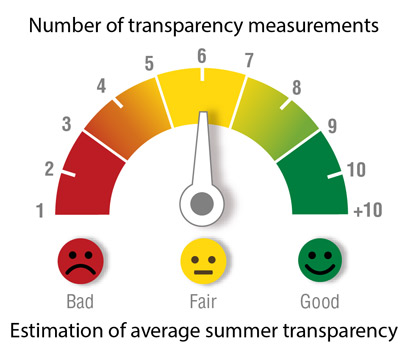Ministère de l’Environnement, de la Lutte contre les changements climatiques, de la Faune et des Parcs

This content is intended for the public covered by the exceptions of the Charter of the French language and its regulations. If you read on, you confirm that you fall within one of these exceptions.
Navigation par thématique
Water section
Réseau de surveillance volontaire des lacs (RSVL)
Why measure water transparency?
- Transparency is one of the indicators for assessing the health of lakes. Generally, the more transparent the water, the better its quality.
- Transparency is the only indicator that is monitored annually under the RSVL. A decrease in transparency over the years could indicate a deterioration in water quality.
- The transparency of some lakes is practically stable while in other lakes it fluctuates by several meters.
- Transparency is influenced by:
- weather conditions (rain, wind, etc.);
- suspended algae;
- suspended particles;
- the presence of dissolved organic matter responsible for the water’s colour.
- The more a lake’s transparency varies, the more often it needs to be measured to obtain valid information. The objective is to take a measurement every two weeks from June to October (ten measurements).
- The performance scale below qualifies the estimation of average transparency obtained based on the number of measurements taken from June to October.

If you refer to the figure above, is the number of measurements taken annually on your lake sufficient to get a good estimation of average transparency?
- A good estimation detects and highlights an improvement or deterioration in average transparency over the years. However, a bad estimation is of little use and fails to detect changes.
- The number of measurements is important, but so is their
quality. How to take good measurements:
- Adhere to the monitoring period (from June to October).
- Spread out taking the measurements over the entire monitoring period.
- Always go to the station’s precise location.
- Follow the measurement method described in the protocol.
- Take the measurements between 10 a.m. and 3 p.m.
- Choose good weather conditions (little wind and no rain).
- Wear contacts or corrective lenses if needed.
- Remove your sunglasses.
- Position yourself with your back to the sun.
- If several volunteers are involved, plan a group outing at the beginning of the season to ensure that the protocol is followed and that the measurements taken by each volunteer are similar.
